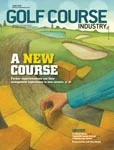Image is everything.
As director of turf operations for Bigwin Island Golf Club in Huntsville, Ontario, one of Canada’s top-ranked golf courses, Scott Heron understands this fact and it’s why he pays particular attention to his annual golf course accessory purchases.
The Bigwin Island course, which Heron and his crew of 27 are responsible for maintaining, is a par-72 layout measuring 7,166 yards from the championship tees. The course is designed with a variety of tee locations measuring 6,742 yards from the blue tees, 6,287 yards from the white tees and 5,346 yards from the red tees. Each nine is a par 36 consisting of two par threes, two par fives and five par fours.
Every year Heron purchases new flags, flagpoles and tee cups for each of his course’s 18 holes. An excessive annual purchase, some golf course superintendents may say, but essential for Bigwin Island, Huron adds.
“They just don’t last,” he says. “The weather coupled with the fact that they’re getting picked up and thrown down all the time marks them up pretty good. And the cups, they really get beaten up by the end of a year’s time.”
Heron tends to purchase accessories based on quality and durability. He wants a flagpole and flag to go the distance from July to July, the typical year these items are pressed into service. Another factor, though, is the relationship he has with his vendor, Bayco Golf.
“I put a lot of trust into the advice that my sales rep offers when I have questions about the accessories I’m about to purchase,” he says. “Also, I value the fact that if there’s a problem during the year with any of these products, they take care of any issues without any worry.”
While not as frequently, Heron approaches other course accessory purchases in the same fashion.
For example, occasionally a tree will damage a course trash can, prompting it to be replaced, or one of the course benches begins to show, that too much be refurbished or replaced.
The cost is minimal, roughly $2,000 per year for all of his course accessory purchases, but the return is invaluable because most often it’s the little things that make a difference in the course’s overall presentation, Heron says.
“Sure you could use these things forever, but they’d look pretty ugly,” Heron says. “It’s one of those things that, by replacing them, none of the members really ever takes notice that they’re new every year. But if you didn’t replace them, and they started to show some wear and tear, then it would begin to attract the attention of the membership.” GCI

Explore the June 2009 Issue
Check out more from this issue and find your next story to read.
Latest from Golf Course Industry
- From the publisher’s pen: Conscientious of a bigger role
- Bernhard and Company partners with Laguna Golf Phuket
- Terre Blanche showcases environmental stewardship
- VIDEO: Introducing our December issue
- Bernhard and Company introduces Soil Scout
- Nu-Pipe donates to GCSAA Foundation’s Centennial Campaign
- GCSAA enhances golf course BMP tool
- Melrose leadership programs sending 18 to 2026 GCSAA Conference and Trade Show





